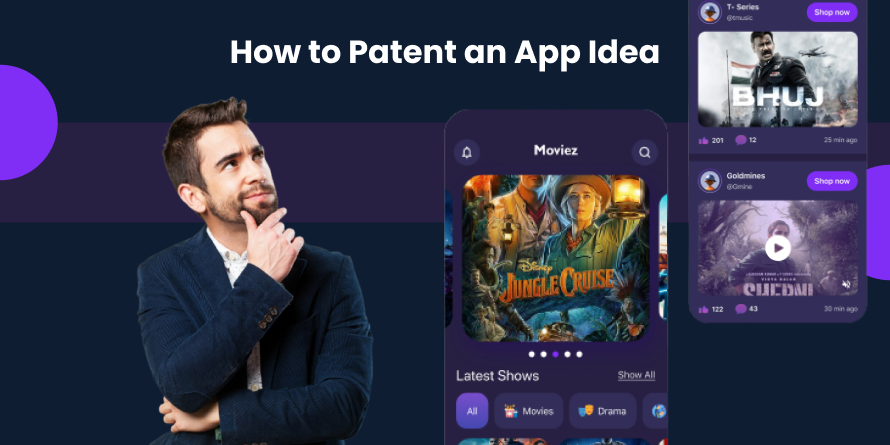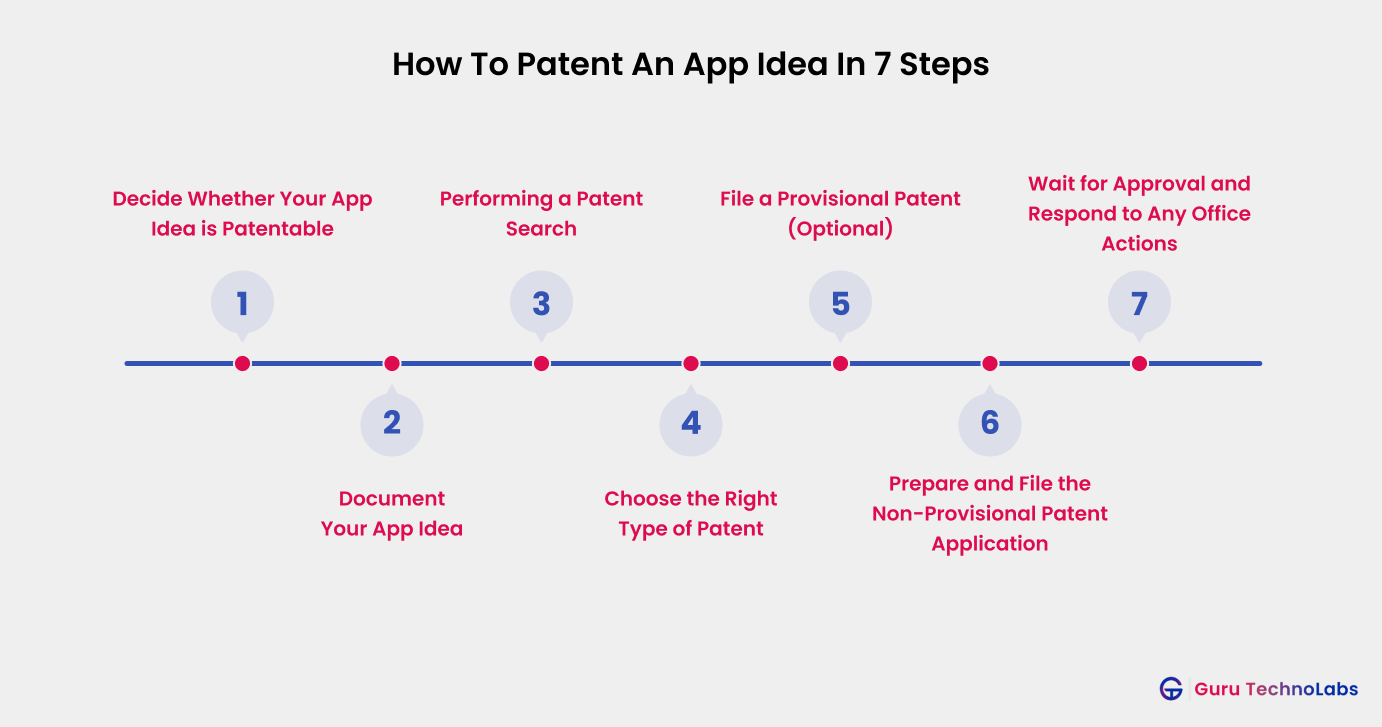How to Patent an App Idea: Tips and Tricks for First-timers

Let’s imagine a world where Instagram, Facebook, WhatsApp, and Snapchat never patented their unique app ideas. These massively popular and billion-dollar apps could have been copied, replicated, or outright stolen by competitors, losing their unique edge and market dominance.
Without securing their intellectual property, these platforms might not have achieved the success and trust they enjoy today. Patenting an app idea is not just a legal formality- it’s the key to protecting the innovation that sets your app apart in an increasingly competitive digital world.
In the overcrowded app industry, where new ideas emerge daily, securing your app’s concept with a patent ensures you’re the one in control. Whether you are just starting or already in development, understanding how to patent an app idea can safeguard your hard work, attract investors, and solidify your place in the market.
Protecting your app’s intellectual property is not just a step- it is the foundation of your app’s long-term success.
What Does It Mean To Patent An App Idea?
Patenting an app idea means officially protecting your concept or invention through legal rights, ensuring no one else can copy, use, or sell your idea without your permission.
Think of it like putting a lock on your front door: it keeps your innovation safe from being stolen or replicated by others. A patent grants you exclusive ownership over your app idea, giving you the power to defend it if someone tries to infringe on your intellectual property.
Take the story of Netflix when it was launched. In the early 2000s, streaming wasn’t the giant it is today. Netflix’s original business model was based on mailing DVDs to customers, but it soon pivoted to streaming. If Netflix hadn’t patented their streaming technology, other companies could have easily replicated the service.
Blockbuster, once Netflix’s biggest competitor, didn’t patent their online rental service, and consequently, Netflix took the lead in the digital revolution.
This example shows how patenting an app idea can protect your innovation from being overtaken, helping you stay ahead of the competition and build a lasting business.
Different Types Of Patent Application
When you are ready to protect your app idea, it is important to understand the different types of patent applications available. Each type serves a unique purpose and is designed for specific stages of your app’s development or innovation.
Let’s break down the most common types of patent applications, so you can make an informed decision on what’s best for you.
Provisional Patent Application
- A provisional patent application is the first step to protect your app idea. It’s a temporary placeholder that allows you to establish an early filing date for your app’s innovation.
- This type of application doesn’t require formal patent claims or a detailed description, making it faster and more affordable to file.
- It gives you one year to develop and refine your app idea before filing a full patent application.
Non-Provisional Patent Application
- A non-provisional patent application is a formal route to securing a patent for your app.
- Unlike the provisional application, this requires a detailed description of your app’s features, functionality, and any drawings that represent its design or technology.
- This is the type of application that will be examined by the patent office, and if granted, it provides you with full patent protection for your app.
- It’s ideal for when you’re ready to move forward with commercializing your app and need strong legal protection.
International Patent Application (PCT)
- If you plan to expand your app globally, an International Patent Application under the Patent Cooperation Treaty (PCT) allows you to seek protection in multiple countries with a single filing.
- This is beneficial for entrepreneurs and businesses aiming to enter international markets.
- The PCT application gives you up to 30 months from the filing date to decide where you want to seek patent protection, making it a flexible option for global expansion.
| Patent Type | Timeframe | Example | Requirements | Best for |
|---|---|---|---|---|
| Provisional Patent Application | 12 Months | Early-stage app ideas | Basic description of your app and its innovation | Protecting early ideas, securing “patent pending” status |
| Non-Provisional Patent Application | 2-5 years (can vary) | Fully developed app (e.g., Uber) | Detailed description, claims, and drawings | Fully protecting your app for commercialization |
| International Patent Application (PCT) | Up to 30 months | Expanding app globally (e.g., Spotify) | Must first file a provisional or non-provisional application | Global protection for apps aimed at international markets |
Have a groundbreaking app idea? Ready to protect it with a patent?
Protecting your intellectual property ensures that others can’t replicate your
hard work. Let’s connect and we will guide you through the patent process.
How To Patent An App Idea In 7 Steps?
In the following section, we have enlisted the core steps in detail about patenting app ideas. To prevent competitors from replicating your unique app idea, you need to patent your app idea.
If you lack adequate resources, shake hands with a mobile app development company, they can assist you in the entire process.

Step 1: Decide Whether Your App Idea is Patentable
Before you begin the application process, it is imperative to establish whether your idea qualifies for patenting. Not all ideas are patentable. For an idea to be patentable, it has to be new, not easily visible to someone skilled in the art, and useful. This means your app has to provide something new or unique not available in the market.
Here is how you can check this:
- Do a patent search to see whether any similar app or technology has ever been patented.
- Check any existing app or technology that could infringe upon your idea.
- If your idea is indeed unique, you’re in good shape to move on to the next steps. If not, start over or refine your idea more.
Step 2: Document Your App Idea
The next step is to document everything about your app idea. Document the entire concept behind the idea, how you develop it, and any sketches or prototypes. This way, the documentation contributes to solidifying your ownership over the idea and may also come in handy when proving originality at some other point in the future.
This documentation gives you the ability to prove, in the case of a dispute, that you were the original inventor of the idea.
Step 3: Performing a Patent Search
After you have documented your idea, the next step is to do a patent search. This provides an overview of whether similar patents exist and may act as a deterrent to patenting your app.
You can do a patent search using the United States Patent and Trademark Office (USPTO) on its databases or by the European Patent Office (EPO).
If you find your app idea to be patent-critical, don’t panic! This could mean you need to refine your idea or find a different angle to make it distinctive.
Step 4: Choose the Right Type of Patent
Choosing the right patent type is important to ensure your app is fully protected according to your needs as determined by the development stages of the app and the way you want to protect it; whether you file for a provisional or a non-provisional patent.
Provisional Patent: Best to go with when you want to attain the “patent-pending” status and need to buy some additional time for 12 months to improve your idea.
Non-Provisional Patent: This is the full formal application advice on this status; this is the application that will provide you with the patent rights after going through the full examination process.
When in doubt, consult a patent attorney to better determine the correct route to take as per your needs.
Step 5: File a Provisional Patent (Optional)
If you would like to secure your app idea while still working it out, the best course of action would be to file a provisional patent. It is inexpensive and allows you to effectively register your ideas for any potential future disputes, while the detail is still being worked out and elaborate design reports are not a necessity.
This step basically “locks” in your idea while you continue to refine it, giving you 12 months to file a non-provisional patent.
Step 6: Prepare and File the Non-Provisional Patent Application
Once you’ve managed to refine your app idea and are ready to execute it, it is time to file a non-provisional patent. It’s much more complex than the provisional one and has claims that clarify, within the work, what parts of your app are different and deserving of protection. This is the green light for the legally recognized documents to be reviewed by the patent office.
What you must include:
- A thorough description of your app, its features, and how it works.
- Claims made to clearly define the aspects of your app that are patentable.
- Drawings or diagrams showing how your app is designed and how it works.
- At this point, it is very good to have a patent attorney involved so that your application is developed accurately and expressively.
Step 7: Wait for Approval and Respond to Any Office Actions
A patent office will take your non-provisional patent application after it has been submitted. This process can take 1 to 5 years depending on how complicated your application is and how many cases are outstanding at a certain office. The office may at some point send you office actions that ask for certain amendments or information regarding your application.
An office action by the patent office is not something to be feared; it is simply a routine function of the whole process. You would be asked to respond to such an office action by clarifying or modifying your application. That should be more than sufficient for your patent draft to finally get through.
By going through these 7 steps, you can understand and successfully navigate the app patenting process that will keep competitors away and give you the confidence to move forward in developing and commercializing your idea.
It seems a long process but one that’s worth taking to safeguard your innovation!
Common Questions When Patenting an App Idea: A Complete FAQ
What is the cost of patenting an app idea?
The cost of patenting an app idea can vary widely based on several factors, but here’s a breakdown of typical expenses:
- Provisional Patent Application: Filing a provisional patent application can cost anywhere between $65 to $300 (if you file yourself). If you hire a patent attorney, the cost may range from $1,000 to $2,500.
- Non-Provisional Patent Application: Filing a full patent application is more expensive, ranging from $5,000 to $15,000 or more. The cost depends on the complexity of your app and whether you use an attorney. This includes preparation, filing fees, and attorney fees.
- Additional Costs: Be aware that there could be additional costs for things like patent drawings or international filings.
While it might seem expensive, the investment in securing your app’s intellectual property can pay off in the long run if it prevents competitors from copying your idea.
Who doesn’t need to patent an app idea?
Not every app needs to be patented. Here are some scenarios where a patent might not be necessary:
- The Idea is Too Generic: If your app idea is just an improvement on existing technologies and lacks any novel features, it may not qualify for a patent.
- Your App Relies on Existing Tools: If your app uses commonly available tools or frameworks without offering something new or unique, patenting may not be the right path.
- Cost Concerns: For some startups or small businesses, the cost of patenting may outweigh the benefits—especially if the app is still in the early stages of development and hasn’t proven its market viability.
Instead of patenting, these businesses might opt for copyrights or non-disclosure agreements (NDAs) to protect their ideas without the need for a patent.
How long does it take to get a patent for an app?
The timeline for receiving a patent can vary depending on many factors, but generally, you can expect the process to take around 2 to 5 years. Here’s why:
- Patent Examination: After filing, the patent office will examine to determine if your app idea meets the necessary criteria. This can take years or more.
- Office Actions: Sometimes, the patent office will require additional information or modifications, which can extend the timeline.
- Backlog: The patent office has a significant backlog of applications, which can cause delays.
It’s a long process, but securing a patent is worth the wait for the protection it provides.
Can You Patent an App Idea Without a Working Prototype?
Yes, you can patent an app idea without a working prototype, but you must provide a clear and detailed description of how the app works. The patent office doesn’t require a fully functional app, but it does need a thorough explanation of:
- How the app operates
- What makes it unique
- The technology used
What’s the Difference Between a Copyright and a Patent for My App Idea?
While both copyright and patents protect intellectual property, they do so in different ways:
- Patent: Protects the functional aspects of your app—how it works, its features, and how it’s developed. Patents are for inventions or new technologies.
- Copyright: Protects the creative aspects of your app, such as its code, design, graphics, and content. Copyright ensures no one can copy or use the visual and content-related elements of your app without permission.
-
In some cases, you may need both—a patent for the technology behind your app and a copyright for its creative elements.
Can I Patent an App Idea in Multiple Countries?
Yes, it is possible to patent an app idea in multiple countries. If you want global protection, you can file an international patent application through the PCT. This lets you seek patent protection in over 150 countries with a single filing.
Keep in mind that patents are territorial, so a U.S. patent won’t protect your app in other countries unless you file internationally.
What happens if someone else copies my app after it’s patented?
Once your app idea is patented, you have the legal right to take action if someone copies it. Here’s what you can do:
- Ceases: You can send a formal letter asking the infringing party to stop using your idea.
- Negotiation: If the other party is using your idea without permission, you might be able to negotiate a licensing agreement.
- Litigation: In some cases, you may need to take the matter to court if the infringement continues.
Having a patent provides you with the legal foundation to defend your app and ensure your intellectual property remains protected.
Conclusion
We hope you have got an answer to how I can patent my app idea. Patenting a mobile app idea is a smart move and technique to keep your innovation safe from others. It doesn’t only restrict access but also eliminates copy issues. It also helps you establish brand authority by having official rights.
If you have a unique app idea, hire a dedicated development team from Guru TechnoLabs and give life to your unique app idea.

















